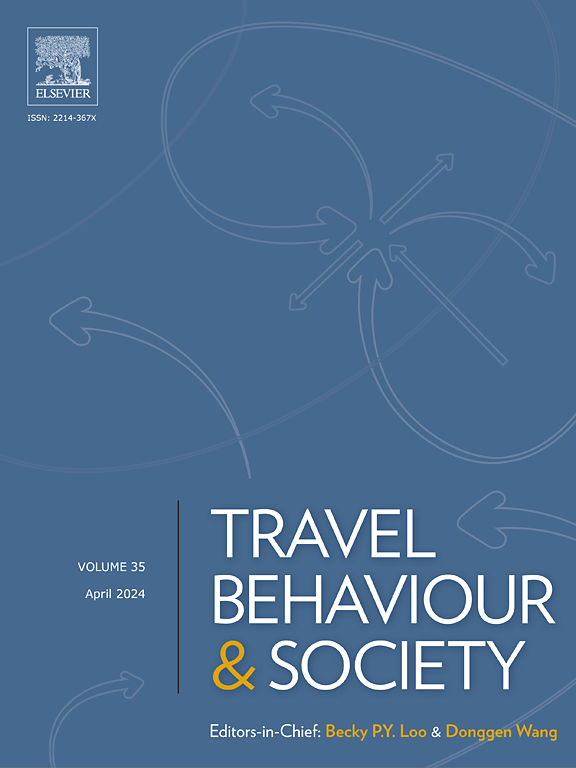城市建成环境与地铁客流量时空异质性的关系研究
IF 5.7
2区 工程技术
Q1 TRANSPORTATION
引用次数: 0
摘要
越来越多的研究强调了了解影响地铁客流量的建筑环境因素对制定未来交通策略的重要性。然而,以前的传统方法依赖于不同时段(高峰时间和非高峰时间,工作日和周末)的总客流量或平均客流量,无法捕捉地铁站的动态时间变化。本研究通过基于24小时周期评估地铁乘客模式来解决这一差距,从而更细致地了解建筑环境特征对乘客模式的影响。该研究以土耳其安卡拉为重点,使用大规模谷歌地图数据确定了地铁乘客的时空异质性,并使用街道和建筑向量和兴趣点(poi)分析了基于网络的集水区(ca)。采用主成分分析和k-means算法,确定了具有独特时间演化的四种不同的每日乘客模式:白天,夜间,低平衡和高峰平衡。随后,利用交互式多项逻辑回归来评估建筑环境指标对这些模式的影响。结果显示,在地铁站层面上,建筑环境特征与日常乘客模式之间存在显著的相互作用。值得注意的是,发现商业poi与熵的相互作用增加了白天和夜间乘车模式的可能性。相反,这些因素的缺乏增加了低均衡模式的可能性。与土地使用密度或多样性相比,居住人口特征成为客流量的一个更有力的决定因素,突出了在过境规划中考虑人口因素的重要性。此外,传统的可达性指标,包括中间性和接近性中心性,被发现不足以确保一致的乘客。不同类型地铁客流量的不同影响机制从微观角度强调了互动关系对于创建平衡和动态的地铁ca的重要性。这项研究为创建更可持续、更高效的城市交通系统提供了重要见解。本文章由计算机程序翻译,如有差异,请以英文原文为准。
Investigating the relationship between built environment and spatiotemporal heterogeneity of metro ridership
A growing body of research highlights the importance of understanding built environment factors influencing metro ridership to shape future transit strategies. However, previous traditional approaches relying on total or average ridership across distinct periods (peak hours and off-peak hours, weekdays and weekends) fail to capture the dynamic temporal variations of metro stations. This study addresses this gap by evaluating metro ridership patterns based on a 24-hour cycle, allowing for a more nuanced understanding of the effect of built environment characteristics on ridership patterns. Focusing on Ankara, Türkiye, the study identified the spatiotemporal heterogeneity of metro ridership using large-scale Google Maps data and analyzed network-based catchment areas (CAs) using street and building vectors and points of interest (POIs). Employing principal component analysis and the k-means algorithm, four distinct daily ridership patterns with unique temporal evolutions were identified: diurnal, nocturnal, low equilibrium, and peaked equilibrium. Subsequently, interactive multinomial logistic regression was utilized to assess the impact of built environment metrics on these patterns. The results revealed significant interactions between built environment features and daily ridership patterns at the metro station level. Notably, the interaction of commercial POIs with entropy was found to increase the likelihood of diurnal and nocturnal ridership patterns. Conversely, the lack of these factors increased the probability of low equilibrium patterns. Residential population characteristics emerged as a more potent determinant of ridership than land use density or diversity, highlighting the importance of demographic considerations in transit planning. Moreover, conventional accessibility metrics, including betweenness and closeness centrality, were found to be insufficient in ensuring consistent ridership. The different influencing mechanisms of various types of metro ridership highlighted the importance of interactive relationships from a micro perspective to create balanced and dynamic metro CAs. This study offers crucial insights for creating more sustainable and efficient urban transportation systems.
求助全文
通过发布文献求助,成功后即可免费获取论文全文。
去求助
来源期刊

Travel Behaviour and Society
TRANSPORTATION-
CiteScore
9.80
自引率
7.70%
发文量
109
期刊介绍:
Travel Behaviour and Society is an interdisciplinary journal publishing high-quality original papers which report leading edge research in theories, methodologies and applications concerning transportation issues and challenges which involve the social and spatial dimensions. In particular, it provides a discussion forum for major research in travel behaviour, transportation infrastructure, transportation and environmental issues, mobility and social sustainability, transportation geographic information systems (TGIS), transportation and quality of life, transportation data collection and analysis, etc.
 求助内容:
求助内容: 应助结果提醒方式:
应助结果提醒方式:


